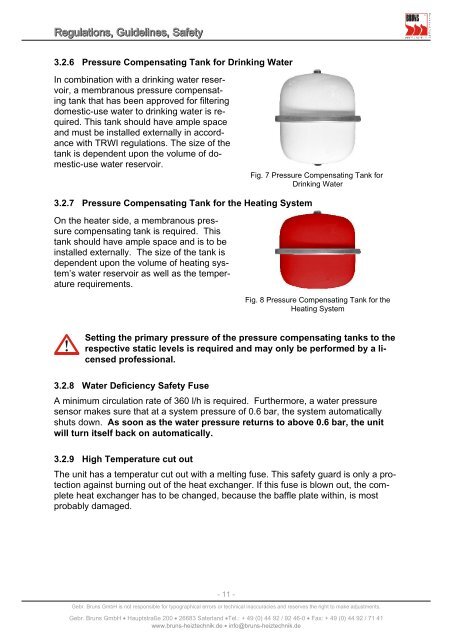Installation and Operating Instruction
Installation and Operating Instruction
Installation and Operating Instruction
Create successful ePaper yourself
Turn your PDF publications into a flip-book with our unique Google optimized e-Paper software.
Regulations, Guidelines, Safety<br />
3.2.6 Pressure Compensating Tank for Drinking Water<br />
In combination with a drinking water reservoir,<br />
a membranous pressure compensating<br />
tank that has been approved for filtering<br />
domestic-use water to drinking water is required.<br />
This tank should have ample space<br />
<strong>and</strong> must be installed externally in accordance<br />
with TRWI regulations. The size of the<br />
tank is dependent upon the volume of domestic-use<br />
water reservoir.<br />
3.2.7 Pressure Compensating Tank for the Heating System<br />
On the heater side, a membranous pressure<br />
compensating tank is required. This<br />
tank should have ample space <strong>and</strong> is to be<br />
installed externally. The size of the tank is<br />
dependent upon the volume of heating system’s<br />
water reservoir as well as the temperature<br />
requirements.<br />
Fig. 7 Pressure Compensating Tank for<br />
Drinking Water<br />
Fig. 8 Pressure Compensating Tank for the<br />
Heating System<br />
Setting the primary pressure of the pressure compensating tanks to the<br />
respective static levels is required <strong>and</strong> may only be performed by a licensed<br />
professional.<br />
3.2.8 Water Deficiency Safety Fuse<br />
A minimum circulation rate of 360 l/h is required. Furthermore, a water pressure<br />
sensor makes sure that at a system pressure of 0.6 bar, the system automatically<br />
shuts down. As soon as the water pressure returns to above 0.6 bar, the unit<br />
will turn itself back on automatically.<br />
3.2.9 High Temperature cut out<br />
The unit has a temperatur cut out with a melting fuse. This safety guard is only a protection<br />
against burning out of the heat exchanger. If this fuse is blown out, the complete<br />
heat exchanger has to be changed, because the baffle plate within, is most<br />
probably damaged.<br />
- 11 -<br />
Gebr. Bruns GmbH is not responsible for typographical errors or technical inaccuracies <strong>and</strong> reserves the right to make adjustments.<br />
Gebr. Bruns GmbH • Hauptstraße 200 • 26683 Saterl<strong>and</strong> •Tel.: + 49 (0) 44 92 / 92 46-0 • Fax: + 49 (0) 44 92 / 71 41<br />
www.bruns-heiztechnik.de • info@bruns-heiztechnik.de



